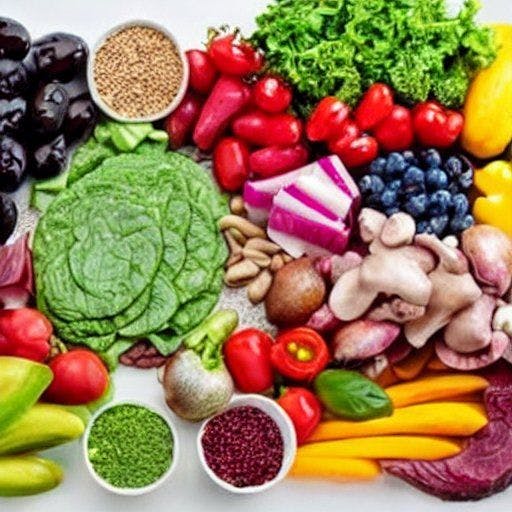
Raw Food Diet is a dietary lifestyle that involves consuming uncooked, unprocessed, and often organic foods. The emphasis is on fruits, vegetables, nuts, seeds, and sprouted grains, which are believed to contain more essential nutrients, enzymes, and vitamins in their natural state.
The goal of the raw food diet is to consume foods in their most natural state, minimizing exposure to heat, which is believed to reduce the nutritional value of foods. This type of diet is often adopted for health, environmental, or ethical reasons.
Preparing for a Raw Food Diet
Preparing for a Raw Food Diet is an exciting and life-changing journey. The Raw Food Diet emphasizes the consumption of raw, unprocessed foods that are minimally cooked or heated to retain the maximum amount of nutrients and enzymes. This diet consists of a variety of fruits, vegetables, nuts, seeds, and sprouted grains, and eliminates processed and cooked foods.
The transition to a Raw Food Diet can be challenging, but with proper planning and preparation, it can be a smooth and enjoyable process. In this guide, we will explore some of the key steps involved in preparing for a Raw Food Diet, including understanding the basic principles of the diet, creating a meal plan, shopping for raw foods, and preparing raw meals.

Choosing the Right Foods
The idea behind this diet is to consume foods in their natural state to retain their maximum nutritional value and enzymes. Some common foods included in a raw food diet include:
- Fruits: such as berries, apples, bananas, mangoes, etc.
- Vegetables: such as leafy greens, carrots, cucumbers, bell peppers, etc.
- Nuts and seeds: such as almonds, cashews, pumpkin seeds, chia seeds, etc.
- Sprouts: such as alfalfa, lentil, and mung bean sprouts.
- Sea vegetables: such as nori, dulse, and kelp.
- Uncooked grains: such as quinoa, buckwheat, and millet.
- Legumes: such as chickpeas, lentils, and beans.
It's important to note that the raw food diet may be restrictive and may not provide enough nutrients, especially protein and vitamin B12. Before starting any new diet, it's recommended to consult with a healthcare professional to ensure it's safe and appropriate for your individual needs.

Preparing Meals
Raw food diet consists of uncooked, unprocessed, and often organic plant-based foods such as fruits, vegetables, nuts, seeds, sprouts, and seaweeds. Here are some meal ideas for a raw food diet:
- Fresh fruit and vegetable smoothies
- Salad with mixed greens, veggies, and a nut-based dressing
- Wrap made with collard greens or lettuce leaves filled with avocado, sprouts, and veggies
- Chia seed pudding topped with fresh berries and nuts
- Veggie nori rolls filled with avocado, carrots, cucumber, and sprouts
- Dehydrated crackers and dips made from nuts and veggies
- Spicy raw "taco" made with walnut meat and seasoned with chili powder and cumin
It's important to consult with a healthcare professional before starting any new diet, especially if you have any dietary restrictions or medical conditions.

Storing Ingredients
Storing raw food ingredients is important to maintain the freshness and nutritional value of the food. Here are some tips for storing raw food ingredients:
- Keep produce cool: Store fruits and vegetables in the refrigerator to maintain their crispness and prevent spoilage.
- Store leafy greens in a damp towel: Wrap leafy greens in a damp towel to keep them fresh for longer.
- Store nuts and seeds in an airtight container: Store nuts and seeds in an airtight container in a cool, dark place to prevent spoilage.
- Store dried fruits and berries in an airtight container: Store dried fruits and berries in an airtight container in a cool, dark place to prevent spoilage.
- Store grains and legumes in an airtight container: Store grains and legumes in an airtight container in a cool, dark place to prevent spoilage.
- Store sprouts in a covered container: Store sprouts in a covered container in the refrigerator to prevent spoilage.
- Store fermented foods in an airtight container: Store fermented foods in an airtight container in the refrigerator to prevent spoilage.
It is important to follow these storage tips to ensure that the raw food ingredients remain fresh and maintain their nutritional value.
Conclusion
The raw food diet has its benefits and drawbacks. On the one hand, it emphasizes the consumption of whole, unprocessed foods which can provide an array of vitamins, minerals, and other nutrients essential for good health. The diet can also help reduce the risk of chronic diseases, promote weight loss, and enhance overall well-being.
On the other hand, the raw food diet can be restrictive and may not provide enough protein, vitamin B12, and other essential nutrients. It can also be difficult to maintain long-term, especially for those who are not used to eating a lot of raw fruits and vegetables.
It is important to consider individual needs and preferences when deciding whether or not to adopt the raw food diet. Individuals who are considering this way of eating should talk to their healthcare provider to ensure that they are getting enough nutrients and to avoid any potential health risks.
